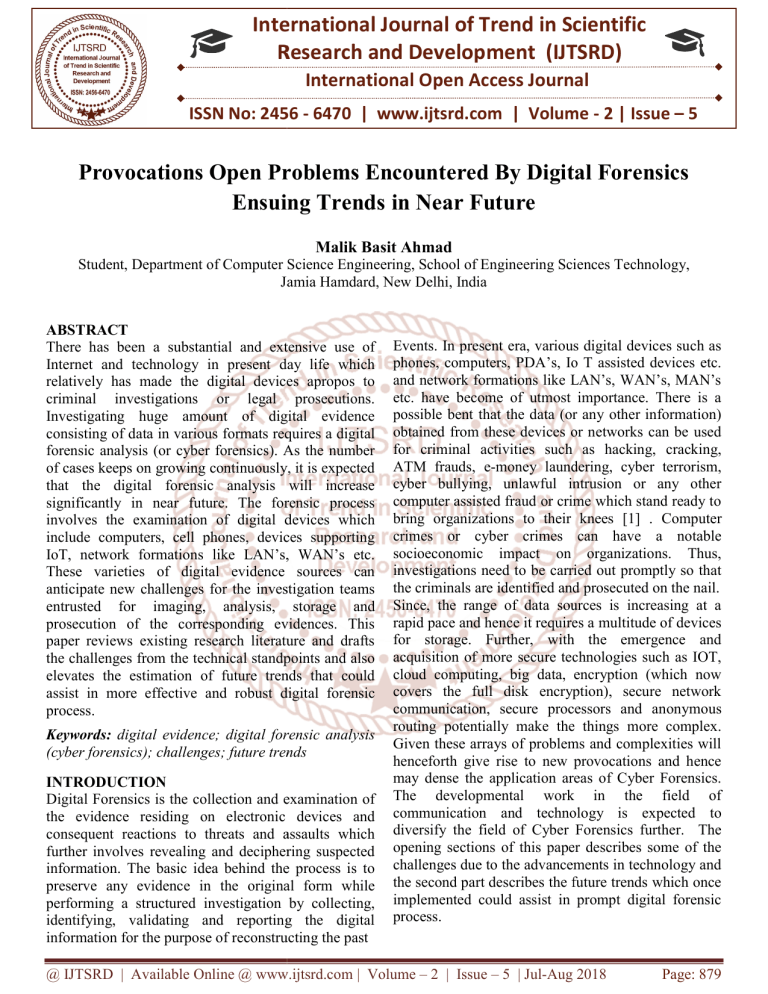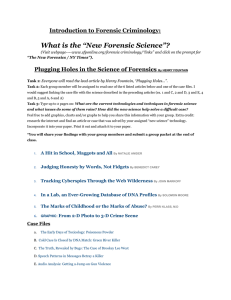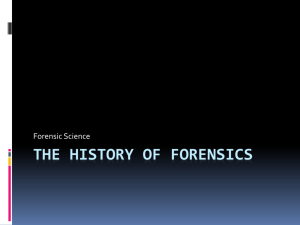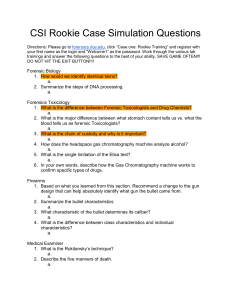
International Journal of Trend in Scientific
Research and Development (IJTSRD)
International Open Access Journal
ISSN No: 2456 - 6470 | www.ijtsrd.com | Volume - 2 | Issue – 5
Provocations Open Problems Encountered By Digital Forensics
Ensuing Trends in Near Future
Malik Basit Ahmad
Student, Department
artment of Computer Science Engineering, School of Engineering
eering Sciences Technology,
Jamia Hamdard, New Delhi, India
ABSTRACT
There has been a substantial and extensive use of
Internet and technology in present day life which
relatively has made the digital devices apropos to
criminal investigations or legal prosecutions.
Investigating huge amount of digital evidence
consisting of data in various formats requires a digital
forensic analysis (or cyber forensics). As the number
of cases keeps on growing continuously, it is expected
that the digital forensic analysis will increase
significantly in near future. The forensic process
involves the examination
ation of digital devices which
include computers, cell phones, devices supporting
IoT, network formations like LAN’s, WAN’s etc.
These varieties of digital evidence sources can
anticipate new challenges for the investigation teams
entrusted for imaging, analysis,
alysis, storage and
prosecution of the corresponding evidences. This
paper reviews existing research literature and drafts
the challenges from the technical standpoints and also
elevates the estimation of future trends that could
assist in more effective and
nd robust digital forensic
process.
Keywords: digital evidence; digital forensic analysis
(cyber forensics); challenges; future trends
INTRODUCTION
Digital Forensics is the collection and examination of
the evidence residing on electronic devices and
consequent
equent reactions to threats and assaults which
further involves revealing and deciphering suspected
information. The basic idea behind the process is to
preserve any evidence in the original form while
performing a structured investigation by collecting,
identifying,
dentifying, validating and reporting the digital
information for the purpose of reconstructing the past
Events.. In present era, various digital devices such as
phones, computers, PDA’s, Io T assisted devices etc.
and network formations like LAN’s, WAN’s, MAN’s
etc. have become of utmost importance. There is a
possible bent that the data (or any other information)
obtained from these devices or networks can be used
for criminal activities such
h as hacking, cracking,
ATM frauds, e-money
money laundering, cyber terrorism,
cyber bullying, unlawful intrusion or any other
computer assisted fraud or crime which stand ready to
bring organizations to their knees [1] . Computer
crimes or cyber crimes can have a notable
socioeconomic impact on organizations. Thus,
investigations need to be carried out promptly so that
the criminals are identified and prosecuted on the nail.
Since, the range of data sources is increasing at a
rapid pace and hence it requires a multitude of devices
for storage. Further, with the emergence and
acquisition of more secure technologies such as IOT,
cloud computing, big data, encryption (which now
covers the full disk encryption), secure network
communication, secure processors and anonymous
an
routing potentially make the things more complex.
Given these arrays of problems and complexities will
henceforth give rise to new provocations and hence
may dense the application areas of Cyber Forensics.
The developmental work in the field of
communication
munication and technology is expected to
diversify the field of Cyber Forensics further. The
opening sections of this paper describes some of the
challenges due to the advancements in technology and
the second part describes the future trends which once
implemented
mplemented could assist in prompt digital forensic
process.
@ IJTSRD | Available Online @ www.ijtsrd.com | Volume – 2 | Issue – 5 | Jul-Aug 2018
Page: 879
International Journal of Trend in Scientific Research and Development (IJTSRD) ISSN: 2456-6470
PROVOCATIONS AND OPEN PROBLEMS:
With the drastic extension and revolution in the field
of computer science and network technologies the use
of pre-existing tools and techniques used for forensic
analysis have become less effective. This revolution
has given birth to data from many sources of digital
evidences and that too in variety of formats as already
described. Analysis of the data and then generating
the meaningful results thus becomes the greatest
forensic challenge facing law enforcement. Further
criminals use anti- forensics to frustrate or create an
overhead to forensic tools, investigations and
investigators [2]. Some of the major challenges
considered to be overhead for Cyber Forensics are
described as follows:
Inception of Big Data
Big Data is a talk of today. It is an evolving term that
describes voluminous amount of unstructured, semistructured or structured data that has a potential to be
mined for information. The diversity of big data is
characterized by Volume, Velocity, Variety, Veracity
and Value of the data which sometimes is also
referred to as 5 V’s of Big Data. Due to its scale,
diversity and complexity there is a requirement for
designing and developing new architectural
framework, techniques and algorithms so as to
harness the hidden knowledge from it [3]. Here the
prime challenge is to identify and collect the evidence
in a timely manner, right when the incident happens.
In addition to this bitwise acquisition is not a
systematic approach due to the size of evidence item.
Again, preservation of an evidence item requires large
disk space which calls for a considerable investment
in forensic labs. For analysis, there is still exists a skill
gap in present era for dealing with huge amount of
data. The final report is expected to reveal accurate
evaluation of tools, methods used and results
generated. Although, certain tools like Map Reduce,
Natural Language Processing, Machine Learning,
Artificial Neural Networks (ANN) are already in use
but they are not suitable for forensic work and hence
new procedures and methods need to be developed
leveraging Big Data [4][5].
Boundless Social Networking:
Use of social networking has gained a momentum
from the past few years and the numbers of users of
these services are increasing at a rapid pace. For
example, Face book currently claims to have 950
million users connected across the globe and same is
the case with other social networking platforms like
Twitter, WhatsApp, Vibe, Snap chat, Instagram etc.
which ultimately has provided feasibility to connect
anywhere, anytime on any device in everyone’s hand.
The increasing use of social media has facilitated the
development of some serious cyber crimes and other
untoward activities. The persons associated with such
activities constantly change their plans and strategies
which in turn tend to pose a challenge to forensic
investigators [6]. In addition to this the number of
users is increasing at a rapid pace, which leads to the
exponential data transactions. Visualizing and
investigating huge amount of data is another
confronting task.
Although, certain tools and other relative programs
have been developed which provide online user
information, but still the forensic extraction from
social networking sites is still has serious research
problem in terms of data completeness and data
compatibility [7].
Internet of Things (Io T)
In present domain, everything seems to be connected
with Internet. Billions and billions of machines and
things which include cars, homes, workplaces,
watches, glasses, home appliances and possibly all
other physical objects that strike our mind are being
connected to Internet thus providing remote access to
visualize and collect data [8]. Although, with the
advent of Internet-of-Things (Io T) the life has
become more comfortable but at the same time it has
provided an edge to cyber criminals in terms of
security and privacy. The spread of this technology
thus poses certain challenges when Io T assisted
devices are involved in any criminal activities [9].
One of the prime challenges is the analysis of the data
spread across different locations. In Io T, data could
be spread across different locations like cloud, third
party location, mobile devices etc. Thus, the location
of evidence is considered as one of the biggest
challenges that can hinder the investigation process
[10]. Another challenge is the limited life span of the
data mainly due to the limited storage in Io T devices.
The life span of the data is short and hence it can be
easily overwritten. The major challenge that can resist
the forensic investigation is the type of device. As
different devices like TV’s, refrigerators, smart
watches etc. are getting added to Io T library, hence
investigating these devices is a challenge in absence
of the predefined protocol.
@ IJTSRD | Available Online @ www.ijtsrd.com | Volume – 2 | Issue – 5 | Jul-Aug 2018
Page: 880
International Journal of Trend in Scientific Research and Development (IJTSRD) ISSN: 2456-6470
Cloud Computing
With the rapid evolution of cloud computing, there
has been a drastic revolution in the field of
Information Technology (IT). Certain business
establishments and organizations have shifted their
route to remote and virtualized environments for
deploying their infrastructure which is often hosted
and managed by third parties[11][12]. The third party
is known as Cloud Service Provider (CSP). The
services provided by CSP can be categorized into
three divisions: Software as a Service (SaaS),
Platform as a Service (PaaS) and Infrastructure as a
Service (IaaS). Cloud computing ultimately involves
the data processing and hence data centers and CSP’s
are always on the hit list of the cyber criminals.
There are certain challenges which once accomplished
can lead to major breakthrough in digital forensic
investigations. Remote data centres, decentralized
data logs, unknown physical locations and volatile
data are the prime challenges to investigations [13].
Here investigations are affected because Cloud
environment is solely CSP dependent which means
that investigator cannot access to virtual instances and
meta-data directly. Hence procedures and tools need
to be developed to overcome the limitations of
forensic investigations to be conducted in cloud
environments.
Wield Of Encryption and Anti-Forensics
Use of encryption in devices, wireless networks and
anti-forensics are other daunting obstacles that may
resist the forensic investigation process. With the
motive of improving security, reliability and
efficiency new cryptographic algorithms and
encryption techniques have been developed which in
turn are posing a challenge for forensic investigators
for recovering digital evidence from computers or
other digital devices [14]. The availability of free
encryption tools like True Crypt, Pretty Good Privacy
(PGP), Bitlocker, File Vault etc. have provided a
wider scope to cyber criminals that can hinder the
working process of forensic investigation [15]. With
the introduction of encryption into operating systems
and Full Disk Encryption (FDE), the investigation has
become a challenge. Forensic investigators may
encounter full disk encryption interface before
machine booting, which therefore makes the recovery
of digital evidence a difficult task [14].
The
encrypted data or a drive can only be accessed with
the help of a key or a password. Investigators
traditionally use Brute Force techniques to guess the
key or they acquire the image of the drive in order to
Decrypt the data or gain access to the drive which
often takes a lot of time. While obtaining evidence
there is always a slight chance that the drive may be
damaged or corrupted. Hence new tools and
techniques need to be developed which are robust and
can help to gather evidence promptly in a safe manner
during forensic investigations.
Anti-Forensics or counter forensics can be defined as
the technique which aims to interfere in and hinder
the forensic investigation process. It is one of the
major upcoming bottlenecks to the forensic
investigation. Marc Rogers of Purdue University
defines anti-forensics as an attempt to negatively
affect the existence, amount and/ or quality evidence
from a crime scene, or make the analysis and
examination of evidence difficult or impossible to
conduct [16]. Anti- Forensic tools are designed and
developed by the programmers with an aim to hamper
the investigation process which can eventually turn
out to be the worst nightmare for the investigator.
There are no general frameworks developed as of now
which could assist in analysis and can gauge the antiforensic situation. Hence, currently forensic
investigations take place in presence of anti-forensic
activities which need to be countered.
ENSUING TRENDS:
The bottlenecks and challenges faced by digital
forensic investigators have inspired the researchers
and the forensic experts to layout the new research
fields which need to be worked upon, so that the
forensic process is carried out in a prompt manner in
near future. Some of the current trending research
developments which are under the scanner of forensic
experts are explained briefly as follows:
Digital Forensics Compute Cluster (DFORC2) :
Law Enforcement Agencies (LEA’s) have been facing
investigation backlogs due to the exponential growth
of HDD storage space. Use of HDD’s with 1 to 2 TB
storage space is very common days which further is
expected to increase to 10 TB and hence might result
in exponential growth of the investigation backlogs.
Further, with the inception of Solid State Drives
(SSD’s) the situation has become even more
challenging as they are expected to provide even more
storage then spinning disk HDD’s.
Hence, investigators need tools which provide quality
throughput. To accomplish this objective, Research
and Development (RAND) was sponsored by
@ IJTSRD | Available Online @ www.ijtsrd.com | Volume – 2 | Issue – 5 | Jul-Aug 2018
Page: 881
International Journal of Trend in Scientific Research and Development (IJTSRD) ISSN: 2456-6470
National Institute of Justice (NIJ) to develop such a
tool which could provide distributed computing
capability and hence can enhance the pace of the
digital forensic process. RAND came up with “Digital
Forensics Compute Cluster” (DFORC2) which is
designed to provide efficient and cost effective
forensic analysis to investigators and LEA’s.
DFORC2 is an open source project that uses Autopsy,
Apache Spark and Kafka. In addition to this it uses
other open source software packages that play a vital
role in integrating data and file analysis steps so that
they can run in parallel rather than in serial process
[17]. DFORC2 is designed keeping in mind the
reduction in infrastructure cost as it runs on a
standalone server or in the Amazon Web Services
(AWS). The results when compared with the
traditional Autopsy prove to be substantially fast and
prompt. In near future RAND plans to establish a high
integrity chain of custody for DFORC2.
Digital Forensics as a Service (DFaaS):
With the increase in computing devices and storage
such as smart phones, routers, GPS enabled devices,
pen drives, flash drives etc. each containing a
voluminous data in a timely manner and with limited
resources, the investigators are facing certain issues
which include backlog, miss of critical time, overlook
of relevant data and lack of understanding.
DFaaS which is a cloud based service provides more
opportunities to overcome these issues. It is an
extension of traditional forensics. Netherland Forensic
Institute (NFI) has incorporated DFaaS as a solution
to huge volume of backlog cases [18]. It involves the
use of shared pool of resources (virtual and
configurable) over a computer network to provide
services. These resources require least management
efforts or human intervention. The inception of this
service will have significant implications on forensics
in near future. Remarkable efforts have been made by
the researchers to develop forensic cloud. SleuthHadoop has made certain efforts to merge forensic
tools into cloud but it restricts the investigators to
build and design the workflow model for analysis as
per the requirements. Hence, the workflow cannot be
implemented and constructed dynamically. Besides,
certain frameworks have been designed and
developed which permit the forensic investigators to
define their requirements in XML files, which can be
used to select the applications as per requirements and
also can be used to generate the corresponding map
reduce drivers which plays a vital role in setting up
the workflow in cloud environment [19]. Although,
potential latency and the available online upload
bandwidth can turn out to be the challenges to DFaaS
but incorporation of such mechanism can facilitate
cloud to cloud based storage event monitoring of
virtual systems.
Computer Forensics Field Triage Process Model
(CFFTPM):
CFFTP is analogous to the first aid which is
conducted just after the incident occurs so as to ease
the investigation process during the execution phase.
Time being a key factor, this model supports on site
analysis of computer systems in question. Prime
considerations of this model are:
Recovery of useable evidence with an immediate
effect.
Identification of victims at acute risk.
To guide the in action investigation.
Identification of potential charges.
To assess the offenders danger to the society in an
accurate manner.
Besides this, maintaining integrity of the evidence
item for examination and forensic analysis is also the
major concern. The ability to perform the examination
and analysis on scene in short period of time may
assist the investigators to reveal the sensitive leads.
This may also help in providing the information
which is important from the psychological viewpoint.
The phases of CFFTPM include:
Planning
Triage
Usage/ user profiles
Chronology/ timeline
Internet activity
Case specific evidence
These six phases form upper level of categorization
and each phase has pre defined sub phases with a
variable task which depends on the specifications of
the case, file system and operating system to be
investigated.
These six phases constitute a high level of
categorization and each phase has several sub-tasks
and considerations that vary according to the specifics
of the case, file system and operating system under
investigation, etc [2]. Further, coupling the field
triage processing model with DFaaS can further yield
the significant benefits in forensic process.
@ IJTSRD | Available Online @ www.ijtsrd.com | Volume – 2 | Issue – 5 | Jul-Aug 2018
Page: 882
International Journal of Trend in Scientific Research and Development (IJTSRD) ISSN: 2456-6470
CONCLUSION
The challenges arising due to the revolution and
discovery of new technologies which keep on
dropping day in and day out have been creating
overhead to forensic experts. In present scenario,
digital forensic layout however is not compatible to
deal with the huge amount of variable data which
changes every instant. With the increase in the
number of internet users at an exponential rate, the
traditional forensic process is facing complications.
Network security, being a trend of today is also
hindering the pre-existing forensic process model to
some extent. Certain machine learning tools are not
validated for forensics as well. These challenges have
opened up the new gateways. Hence the field of
digital forensics has been diversifying since then.
Although, DFORC2, DFaaS and CFFTPM are the
current areas of investment for researchers but due to
the rapid advancements in the cyber world the efforts
need to be amplified in order to match with the
present dynamic tech savvy requirements.
REFRENCES
1. Matthew N. O. Sadiku, Mahamadou Tembely, and
Sarhan M. Musa, Digital forensics , vol 7 of
International Journal of Advanced Research in
Computer Science and Software Engineering; pp.
275-276.
2. N. M. Karie and H. S. Venter, Taxonomy of
challenges for digital forensics, “Journal of
Forensic Sciences”, vol. 60, no. 4, July 2015, pp.
885-893.
3. “What Is Big Data and What Does It Have to Do
with IT Audit?”, ISACA Journal, 2013, pp.23-25.
4. Khan M, Chatwin C, and Young R, “A framework
for post-event timeline reconstruction using neural
networks” Digital Investigation 4, 2007.
5. Pearson G, “A Road Map for Digital Forensic
Research”. In: Report from DFRWS 2001, First
Digital Forensic Research Workshop, 2001.
6. Mohd Najwadi Yusoff,
Ali Dehghantanha,
Ramlan Mahmod, Forensic Investigation of Social
Media and Instant Messaging Services in Firefox
OS, Elsevier, pp.41-62.
7. S. Teelink and R. Erbacher, Improving the
computer forensic analysis process through
visualization, Communications of the ACM, vol.
49(2) 2006, pp. 71–75.
8. David Lillis, Brett A. Becker, Tadhg O’Sullivan
and Mark Scanlon, Current challenges and future
research areas for digital forensic investigation,
Annual ADFSL Conference on Digital Forensics
Security and Law, May 24, pp. 9-20 .
9. Zhang, Z.-K., Cho, M. C. Y., Wang, C.-W., Hsu,
C.-W., Chen, C.-K., & Shieh, S. (2014). IoT
Security: Ongoing challenges and research
opportunities. In 2014 IEEE 7th International
conference on service-oriented computing and
applications pp. 230-234.
10. Liu C., Singhal A., Wijesekera D. , Identifying
evidence for cloud forensic analysis. In: Peterson
G., Shenoi S. (eds) Advancesin Digital Forensics
XIII. 410 of the series IFIP Advances in
information and communication technology, In
2017 Springer, Berlin, Heidelberg, pp. 111-130.
11. George Grispos, Tim Storer and William Bradley
Glisson, Calm before the storm: The challenges of
cloud computing in digital forensics.
12. Stephen O’Shaughnessy, Anthony Keane, impact
of cloud computing on digital forensic
investigations, HAL, pp. 291-303.
13. Meyer, G., & Stander, A. (2015). Cloud
computing: The digital forensics challenge.
Proceedings of Informing Science & IT Education
Conference (InSITE) 2015, pp.285-299.
14. Eoghan Casey, Gerasimos J. Stellatos, Stroz
Friedberg, The impact of full disk encryption on
digital forensics.
15. Sarah Lowman, The effect of file and disk
encryption on computer forensics.
16. Halim Maulana, Raden Muhammad Khalil
Prasetyo, Analyzing the effect of anti-forensics of
digital techniques to digital forensics examination.
17. Daniel Gonzales, Zev Winkelman, Trung Tran,
Ricardo Sanchez, John Hollywood, and Dulani
Woods, Digital Forensics Compute Cluster
(DFORC2) – A New High Speed Distributed
Computing Capability for Digital Forensics,
WMSCI 2017, pp. 126-131.
18. David Lillis, Brett A. Becker, Tadhg O’Sullivan
and Mark Scanlon, Current challenges and future
research areas for digital forensic investigation,
CDFSL Proceedings 2016, pp. 10-20.
19. Yuanfeng Wen, Xiaoxi Man, Khoa Le and
Weidong Shi, Forensics-as-a-Service (FaaS):
Computer forensic workflow management and
processing using cloud , The Fourth International
Conference on Cloud Computing, GRIDs, and
Virtualization, 2013, pp. 208-214.
20. Marcus K. Rogers, James Goldman, Rick Mislan,
Timothy Wedge, Steve Debrota, Computer
Forensics Field Triage Process Model, Journal of
Digital Forensics, Security and Law.
@ IJTSRD | Available Online @ www.ijtsrd.com | Volume – 2 | Issue – 5 | Jul-Aug 2018
Page: 883




